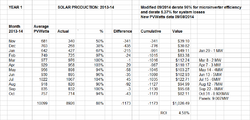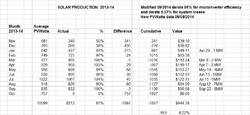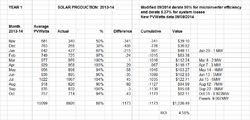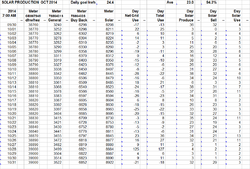Hard to believe that one full year of PV is in the bank. The market was "down" a bit, with an ROI of 4.58% vs 5.18% had the Average PVWatts production been met. The "loss" occurred primarily in Nov, Dec and Jan, with production falling short by 991 kwh, and the balance of the year failing to meet average by 182 kwh. No complaint, however, because the same money invested in a CD would have produced only about a 1% return on a one year CD. But, one year does not an average make, so on to Year 2 and wait and see what the outcome will be.
As of Oct 8 credits on my electric bill were $728.00, and additional credits will be added with the billing and meter reading as of Nov 8. Based on last year's bills for Nov ($35), Dec ($59) and Jan ($54), and credits starting to accumulate beginning with Feb (-$41), I look forward to receiving a healthy check from my utility for the excess credits. One way to look at the check for excess credits is to consider it as dividends for an investment I have made in my utility to provide it with Net Zero power, and a dividend for an investment in the community to provide all of us with cleaner air to breath, fresher water and an improved environment from reduced acid rain, mercury and other pollutants, as well as a smaller hole in the ground from reduced usage of coal.

I also accumulated other data which is informative. I used 7120 kwh for utility interruptible service at a reduced rate (electric heat and domestic hot water, about 100 kwh/mo for dhw and average 500 kwh/mo for heat). I also used 3522 kwh of utility general service (about 300 kwh/mo), for a total of 10,642 kwh of utility grid usage. The utility also bought from me 6852 kwh, and I directly used 2070 kwh of PV production. My total electric usage was 12,712 kwh (1060 kwh/mo), which I believe to be above average because of above normal usage of electric heat due to the very cold winter last year.
During this first PV year we also converted nearly all of our lighting to LED. We also are very good at turning off lights when not needed and we have most electronics on power strips which we turn off when not being used. Except for the wood stove which meets most of our heating needs, our house is all electric, and substantial usage would relate to the electric clothes dryer, stove top, and oven. Any additional electric energy conservation at this time would be very difficult.
The final observation is -- very satisfied with the PV and look forward to future dividends for self and community.



 My 'low water' mark is 8.975 Best so far was 74.031
My 'low water' mark is 8.975 Best so far was 74.031 

